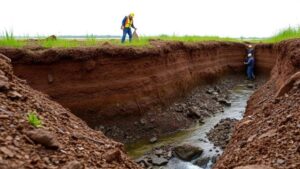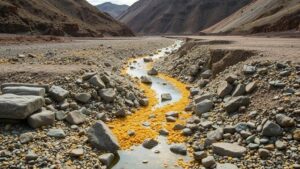Spotting Natural Boulder Fields as Indicators of Downstream Gold Pay Zones
Spotting Natural Boulder Fields as Indicators of Downstream Gold Pay Zones
The connection between natural boulder fields and gold pay zones has become increasingly recognized in the fields of geology and mineral exploration. These boulder fields can serve as valuable indicators, providing insight into the underlying geologic structures and processes that may lead to the discovery of economically viable gold deposits. This article will explore the relationship between these natural formations and gold pay zones, supported by concrete examples and relevant statistics.
Understanding Boulder Fields
Boulder fields, often characterized by large, naturally occurring rocks spread across an area, form through various geological processes such as erosion, glacial action, or weathering. r formation is critical to understanding how gold can be transported and deposited within a landscape.
In many mining regions, boulder fields are formed from weathered bedrock that has eroded over millennia. This process often releases mineral-rich sediments, including gold, into the surrounding environment. These sediments can accumulate along riverbanks or in low-lying areas, creating what are known as pay zones.
The Geological Significance of Boulder Fields
The significance of boulder fields in gold exploration lies primarily in their geological origin and the processes that lead to their formation. Key factors include:
- Source Rock: The composition of the underlying bedrock often determines the presence of gold. For example, volcanic rocks can host gold-bearing veins which, upon weathering, release gold into surrounding sediments.
- Transport Mechanisms: Rivers and glacial activity transport gold-bearing sediments downstream, concentrating them in lower elevations or geological traps where boulder fields may develop.
- Weathering Processes: The chemical and physical breakdown of rocks not only alters their structure but also can enhance gold liberation from the primary source.
Recognizing Indicators of Pay Zones
Spotting boulder fields indicative of downstream gold pay zones involves a combination of geological surveying and field assessments. Explorers look for certain key indicators:
- Presence of Large Quartzite Boulders: Quartz is often a host for gold deposits, making quartzite boulders significant as markers for potential pay zones.
- Coloration and Oxidation Patterns: Yellow or rust-colored rocks might indicate iron oxides associated with gold deposits. e color cues provide visual indicators for gold exploration.
- Mineral Associations: The presence of minerals such as pyrite or arsenopyrite can signify nearby gold deposits as they often form in similar geological settings.
Case Studies and Real-World Applications
Several case studies illustrate the connection between boulder fields and downstream gold pay zones:
- Yukon Territory, Canada: In this region, extensively studied boulder fields near riverbanks have led to significant gold discoveries. By analyzing the composition of boulders and the surrounding sediments, geologists have successfully identified high-pay zones.
- Witwatersrand Basin, South Africa: Known for its vast gold reserves, the basins erosional processes expose boulder fields rich in mineral deposits. Continued exploration and analysis of these fields have revealed multiple economically viable gold seams.
Challenges and Considerations
Despite the potential for discovering gold in boulder fields, there are important challenges to consider:
- Environmental Impact: Exploration activities can disrupt ecosystems and alter natural landscapes. Sustainable practices are essential, requiring exploration companies to balance prospecting with ecological preservation.
- Access and Safety: Many boulder fields are located in remote areas, presenting logistical challenges that can complicate exploration. Safety protocols must be strictly adhered to in such environments.
Actionable Takeaways
To capitalize on the potential of spotting natural boulder fields as indicators of downstream gold pay zones, follow these actionable steps:
- Conduct thorough geological surveys before establishing exploratory digs in potential boulder field areas.
- Use geochemical assays to analyze boulder compositions and identify mineral associations.
- Develop sustainable exploration strategies that minimize environmental impacts while maximizing resource recovery.
To wrap up, natural boulder fields offer crucial insights into the potential presence of downstream gold pay zones. By understanding their geological context and indicators, miners and geologists can enhance their exploration strategies, ultimately leading to more efficient and successful gold extraction efforts.



